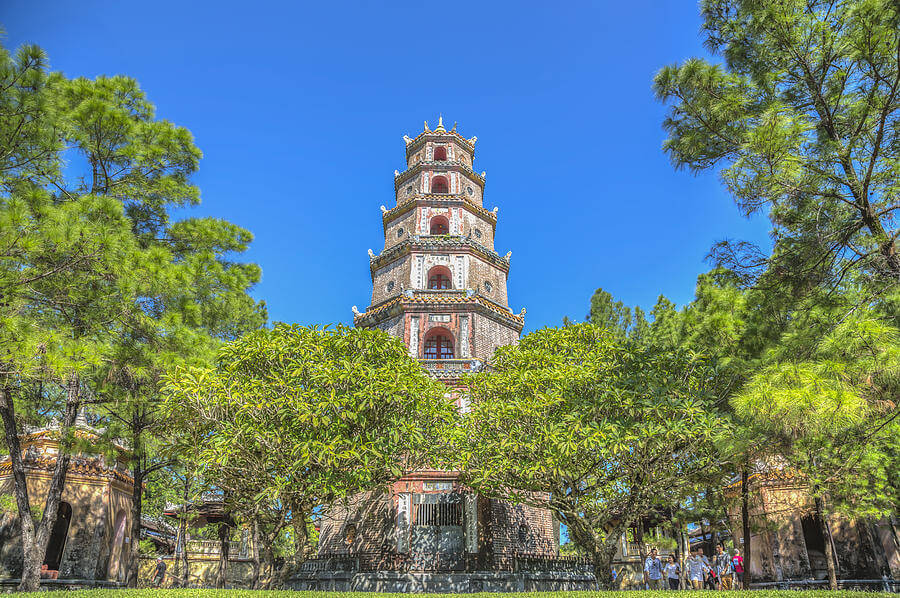THIEN MU PAGODA – THE MOST HOLY PAGODA IN HUE
Table Of Contents [hide]
1. History of Thien Mu Pagoda.
Thien Mu pagoda (Also called Heavenly Lady Pagoda) is the oldest monument in Hue with the wonderful Royal architectures, poetic views, and perfect Feng Shui. It has gained a reputation for not only its ancient beauty but also its mysterious stories.

Linh Mu Pagoda lies on Ha Khe Hill, on the Northern bank of Perfume River in Hue city. It is about 5 kilometers from the center to this amazing area.
2. Stories about Thien Mu pagoda
2.1. Origin of the name Thien Mu.
In 1601, Nguyen Hoang- the first Lord of Nguyen Kingdom came to Thuan Hoa province. He heard an unquestioned story from the local villagers. They rumored that every night, there was a beautiful lady from the Heaven appeared on the hill. She told that “ one day, a true king will build a pagoda here for country’s peacefulness and prosperity”. On hearing that, Nguyen Hoang immediately built a Buddism temple and named for it as Thien Mu. Lately, in 1862, Tu Duc Emperor changed it into Linh Mu to be more respectful.
2.2. Love curse Thien Mu
As you know, local couples, who love each other but not yet married, they don’t dare to come to Heavenly Lady pagoda together. At that time, there was a poor orphaned boy loving with a daughter of a well-off family. Unfortunately, the girl’s parents forced them to fall apart. As a consequence, they decided to kill themselves in the Huong River yard ( in front of Linh Mu Pagoda ) to show their true love. Ironically, the boy died, but villages saved the girl. Gradually, she forgot the boy, got married to a rich mandarin and led a wealthy life. The miserable soul of the boy knew the painful story; consequently, he cursed that every couple coming to Linh Mu Pagoda would break up. Until now, it is an unforgettable sad love story in the mind of the locals.
3. Thien Mu Pagoda views looked from outside
4. What to see at Thien Mu Pagoda?
4.1. Phuoc Duyen Tower

From the high altitude, the holy pagoda looks like a giant dragon is turning its large back. From the Perfume river, it is easy to see Phuoc Duyen Tower. It was a birthday gift from Tu Duc Emperor offered to his grandmother in 1844. One special thing in this tower is that there is a statue of Buddha placed to face the south on every floor. Ongoing inside the tower, you can see a spiral staircase leading to the top floor where a golden Buddha statue was previously on display.
4.2. Giant Turtle And Dai Hung Chung
Looking around in the left and right corners, visitors can enjoy the beauty of the giant turtle, made by marble in 1675. As you know, Turtle is one of the four holy animals in Vietnam. The symbol of longevity and education. So that’s why some students, before taking examinations they come here to touch the head of the turtle to get good luck. The stele on the back of the turtle is a commemoration of Lord Nguyen Phuc Chu’s renovation. The text inscribed on the stele, penned by the Lord, portrays the new buildings of the pagoda, praises Buddhism, as well as the monk, helped the Lord spread the faith throughout the region.
On the left-hand side, there is a pavilion featuring a huge bronze bell, named Dai Hong Chung. Cast in 1710, the bell’s dimensions make it one of the most achievements in bronze casting in Vietnam at that time. It weighs nearly 6,000 pounds, is 4.5 feet high, and is audible up to 6 miles far away.
4.3. Three Door Gate and Dai Hung Shrine
Entering in the Three-door gate with 12 holy guardians, we will reach Dai Hung Shrine. The sanctuary shrine that people pray and worship three Buddha statues, symbols of the past, present, and future, three lives of human beings. It is also the place where Buddhist monks worshiped.
4.4. Austin Car and The Stupa
Walking to the backyard, we will see a beautiful rockery. It is for decoration but also to be an air conditioner. To make weather cooler in summer and warmer in the winter. There is a large yard with many fabulous bonsai trees. Each monk in the pagoda takes care of one. A bit further, there is an Austin car. The car of Thich Quang Duc Monk who burnt himself in 1963 to against Ngo Dinh Diem Regime. Asking for the freedom of people to follow Buddhism.
The last one in the pagoda is the stupa. The grave of the first head monk Thich Don Hau. Following the tradition, when normal people died, we put them in coffins to bury. But to the monks, we do the cremation.
5. How to get there?
Nowadays, tourists are able to reach Linh Mu pagoda by dragon boat along the river and enjoying the Hue Royal Court Music. Plus, you might rent a bike, or a motorbike, or even go for a walk to get there. Besides, if you wish to enjoy the most authentic experience, you can book Hue City tour or Hue City Group Tour at Culture Pham Travel.

Comments
Post a Comment